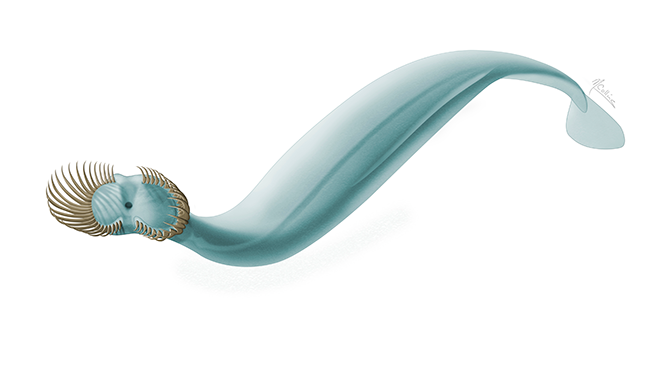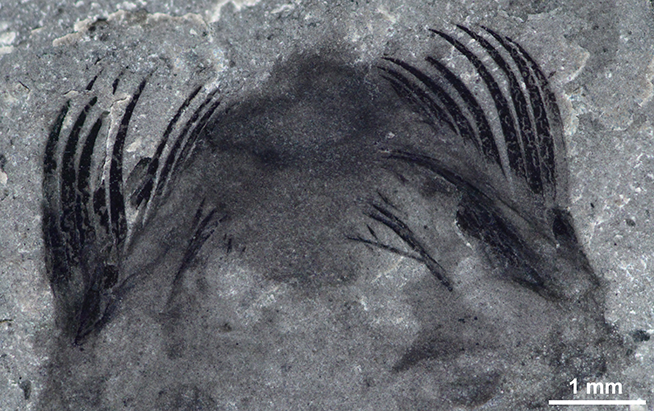Meet a Worm with Invisibility Powers

New species of fossil worm with a big bite, discovered in the Burgess Shale.
Decades of ROM discoveries and research has culminated in the naming of a new fossil species that belongs in a mysterious group of predatory marine invertebrates that are still alive today, called arrow worms. Capinatator praetermissus, which literally means, “a swimming and grasping animal which remained overlooked for a long time,” comes from the famous 508 million year old Burgess Shale site in British Columbia. Its description, published in August 3, 2017 in the scientific journal Current Biology, is significant because it shows that primitive arrow worms were much larger and had evolved greater number of spines around their mouths, compared to modern species, which are miniaturized and mostly planktonic. The study is based on the largest and best-preserved collection of fossils of this tiny phylum anywhere, and the new fossil species is one of the oldest examples of fossilized arrow worms known to scientists.
The arrow worms are a rather enigmatic phylum of marine invertebrates. Formally known as chaetognaths, which means “bristle jaws,” because of the conspicuous claws around their mouths, these arrow-shaped animals have translucent bodies that make them difficult to spot even under the best of circumstances. Their sharp claws are almost as long as their heads, and can splay apart astoundingly fast, projecting forward and closing in on anything unlucky enough to be within striking distance. It is very fortunate for us that chaetognaths are so tiny. These animals grow to only a few millimeters in length, so they cannot do us, or other larger animals, any harm.

Chaetognaths are abundant in marine plankton and live in most oceans of the world, from deep seas to shallow marine communities. Although they are planktonic and therefore cannot swim against strong currents, chaetognaths can still swim in short bursts to capture prey, thanks to their delicate lateral and caudal fins. They are an important part of the food web, preying on other planktonic species—and are consumed by larger plankton-eating animals, including the largest of all animals on Earth, the blue whale!

There are around 120 species of chaetognaths known today, but the evolutionary relationships among them, and especially in relation to other animals, remain poorly understood. Unfortunately, the fossil record of chaetognaths is also very poor because their bodies are mostly composed of water, so, most of the time, only their hooks, if anything, are preserved. This low level of preservation makes it even more remarkable that a collection of about 50 arrow worms dating back to the Cambrian period have been fossilized in good enough condition to be described scientifically. These fossils, nearly 508 million years old, come from various Burgess Shale sites in British Columbia, and were recovered between 1983 and 2016 by Royal Ontario Museum researchers. Surprisingly, the fossil chaetognaths are much bigger than their modern counterparts: the largest individual is at least 10 centimeters long. This species also has around 25 pairs of hooks around its mouth, at least double the number of hooks known in modern forms. This animal must have been a terrifying sight for its would-be prey! These newly described fossils tell us that Cambrian chaetognaths were very large and probably lived close to the ocean floor because their bodies were occasionally trapped into mudflow deposits with other benthic organisms. The miniaturization and planktonic lifestyle we see in most chaetognaths today may have evolved later.

Although the first ROM chaetognaths were collected in 1983, only now are we able to describe this animal formally. It is not a straightforward process to go from flattened fossils like these chaetognaths from the Burgess Shale to 3D representations of what the animals might have looked like in life: we needed to compare many specimens buried at different angles to give us an idea of the animal’s entire anatomy. With every new specimen discovered, our understanding grew. Photographic and analytical techniques also improved in recent years, which made interpreting the fossils much easier. My colleague, Derek Briggs from Yale University, had started working on the first specimens in 1983—specimens discovered by my predecessor, Dr. Desmond Collins. A few years ago, Dr. Briggs and I decided that the time was ripe to finally publish the important ROM findings that we had been building on for years. The name we gave to the Burgess Shale fossil chaetognath species, Capinatator praetermissus, partially acknowledges the time that it took to finally publish our description of the animal. The genus name, Capinatator, means grasping and swimming, and the species name, praetermissus, means overlooked. The origin of modern biodiversity can be traced to the Cambrian period, so adding a description of a new animal representing an entire phylum—the Chaetognatha—is particularly significant for our understanding of evolutionary biology. Now that its description has been published in the journal Current Biology, this rather scary looking creature has a proper name and a connection to a branch of the animal tree of life. And some specimens are also destined to become part of the future Early Life gallery, so visitors will be able to see for themselves the fossils that had remained obscure for so long.
